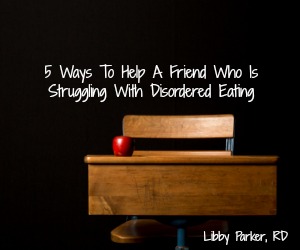Course schedule in hand, check. New notebooks, check. First-day-of-school-outfit, check. Breakfast,… ummm…
For many students the start of school is not just about a new season of books, homework, and friends; the start of school is a new phase of an eating disorder bubbling up in attempt to “control” the situation.
Disordered eating is something that an estimated 4-25% (!) of college students struggle with, based on my research. That is quite a range, but as they are secretive illnesses many go undetected and are thus are hard to catch. The great majority of these students will go undetected until things get very bad, or they figure out how to recover. School is a big time of transition, and any time there is a transition in life an eating disorder may pop-up.
Many people picture a thin, white, teenage girl when they think about what an eating disorder “looks” like, but in reality that is a very small subset of the population. Eating disorders affect people of all races, ages, genders, weights, religions, and sexual orientations. Most people with food issues are not ones that you would think just by looking at them. Most are of “normal” weight and seem to have their life together.
What are some signs that someone may be struggling with their relationship to food? While each individual is different, some common behaviors are:
· Skipping breakfast/not eating much earlier in the day (this typically leads to eating a lot/binging at night)
· Calorie counting everything they eat (or think about eating), usually to compare what has the least calories
· Obsessing about what their food is made of (ingredients, “whole” foods, organic, etc.)
· Avoiding social situations because there might be food present
· Eating significantly large amounts of food alone (and feeling out of control)
· Exercising to “burn off” what they ate (too much exercise is NOT healthy!)
· Going to the bathroom after meals to purge (usually this happens within an hour of eating)
· …and much more! This is by no means an exhaustive list. Find out more about eating disorder signs and symptoms HERE.
What can you do if you think someone you love is experiencing disordered eating?
1. Carefully confront them from a place of caring using “I statements”. An “I statement” looks something like: “I am concerned that I never see you eat, despite how many times we all go out to dinner together. I am worried about your health.” Or, “I see you spending an awful lot of time at the gym, and am worried you are not letting your body have time to repair itself.”
2. As a friend, you should not be the food police – but you can be the person that makes the difference between someone getting help or not. Be willing to help them seek out therapy appointments, and go with them if they feel the need for support.
3. Don’t talk about weight/body shape (yours or anyone else’s). We need to change the norms around what is acceptable to talk about.
4. Model healthy eating habits. This is generally 3 meals a day, plus snacks as needed, or 5-6 “mini-meals” depending on your eating preferences. Food should encompass all food groups, and be relatively balanced without being obsessive. For the general person consuming adequate calories, about 45-65% of calories should come from carbohydrate (grains, fruit, veggies, beans/legumes, nuts/seeds, dairy), 20-30% from fats (oils, avocado, nuts/seeds), and 10-35% from protein (meats, eggs, dairy, nuts/seeds, beans/legumes, soy). A normal, healthy, diet provides space for what sounds good in the moment. The gold standard statement of what “normal eating” is (by Ellyn Satter) can be found HERE.
5. Help them deal with the underlying cause (if you can). Eating disorders are not about the food. Food is used as a coping mechanism for another problem. Much like an alcoholic uses booze to numb the pain or check-out of a situation, people with eating disorders use food to cope. Help them deal with the problem head-on, help them to de-stress, or help to take their mind off the problem in a healthy way (bowling, anyone?).
I hope this raises some awareness of a very complex set of disorders. To learn more about the 4 main types of eating disorders (binge eating, anorexia nervosa, bulimia nervosa, and other specified feeding and eating disorder) check out www.eatingdisordertraining.com, and for more on how to find help and about nutrition check out www.notyouraveragenutritionst.com.


